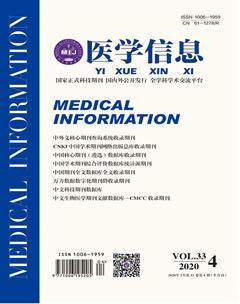miR-449對骨髓間充質干細胞成骨分化調控的機制研究
蘇華斌 胡波涌 葉俊杰



摘要:目的 ?探究miR-449是否具有調控骨髓間充質干細胞(MSCs)成骨分化的作用。方法 ?分離、培養(yǎng)骨髓MSCs,采用流式細胞儀檢測CD44、CD29、CD34、CD45等表面相關標志抗原的表達鑒定骨髓MSCs;將MSCs分為對照組、miR-449a組、miR-449b組及anti-miR-449組,對照組用成骨誘導培養(yǎng)基培養(yǎng),其余各組分別經miR-449a/b或inhibitors轉染后在成骨誘導培養(yǎng)基培養(yǎng),分別于培養(yǎng)第3、6、9、12天檢測各組堿性磷酸酶活性,qRT-PCR檢測miR-449a/b對成骨特異性基因Runx2、Osterix表達的影響。結果 ?①第4代間充質干細胞CD44、CD29表達陽性,而CD34 和CD45表達陰性,符合骨髓間充質干細胞的特征。②成骨誘導培養(yǎng)3、6、9、12 d后,MSCs細胞堿性磷酸酶活性較上一時間點升高,且呈時間依賴性,差異有統(tǒng)計學意義(P<0.05);MSCs成骨誘導培養(yǎng)3、6、9、12 d后,Runx2、Osterix表達水平逐漸升高。③miR-449a組和miR-449b組AKP活性低于對照組,而anti-miR-449組AKP活性升高,差異有統(tǒng)計學意義(P<0.05);miR-449a組和miR-449b組 Runx2、Osterix表達較對照組下調,差異有統(tǒng)計學意義(P<0.05)。結論 ?本次實驗成功分離、培養(yǎng)了骨髓MSCs,其具有體外成骨分化能力,而miR-449能抑制骨髓MSCs向成骨分化。
關鍵詞:miR-449 a/b;間充質干細胞;成骨分化
中圖分類號:R329 ? ? ? ? ? ? ? ? ? ? ? ? ? ? ? ? 文獻標識碼:A ? ? ? ? ? ? ? ? ? ? ? ? ? ? ? ? ? DOI:10.3969/j.issn.1006-1959.2020.04.021
文章編號:1006-1959(2020)04-0069-04
Abstract:Objective ?To investigate whether miR-449 can regulate the osteogenic differentiation of bone marrow mesenchymal stem cells (MSCs). Methods ?Bone marrow MSCs were isolated and cultured. Flow cytometry was used to detect the expression of surface-associated marker antigens such as CD44, CD29, CD34, and CD45. Bone marrow MSCs were identified. The MSCs were divided into control group, miR-449a group, miR-449b group,and anti-miR-449 group, the control group was cultured with osteogenic induction medium, and the remaining groups were cultured in osteogenic induction medium after transfection with miR-449a / b or inhibitors, respectively in culture 3, 6, 9, and12 d, the alkaline phosphatase activity was detected in each group, and the effect of miR-449a / b on the expression of osteogenic specific genes Runx2 and Osterix was detected by qRT-PCR. Results ?①The fourth generation of mesenchymal stem cells was positive for CD44 and CD29, while the expression of CD34 and CD45 was negative, which is in line with the characteristics of bone marrow mesenchymal stem cells. ②After 3, 6, 9, 12 d of osteogenic induction culture, the alkaline phosphatase activity of MSCs cells increased compared with the previous time point, and it was time-dependent,the difference was statistically significant (P<0.05). After 3,6,9,12 d of osteogenic induction of MSCs, the expression levels of Runx2 and Osterix gradually increased. ③The AKP activity of miR-449a group and miR-449b group was lower than the control group, while the anti-miR-449 group increased AKP activity, the difference was statistically significant (P<0.05); miR-449a group and miR-449b group Runx2, Osterix expression was down-regulated compared with the control group,the difference was statistically significant (P<0.05). Conclusion ?This experiment successfully isolated and cultured bone marrow MSCs, which has the ability to differentiate into bone in vitro, and miR-449 can inhibit the differentiation of bone marrow MSCs into osteogenesis.
3討論
BMP/ Smad信號通路調控成骨化和成軟骨化,是骨形成中最重要的一條信號通路。其中Smad4(mothers against decapentaplegic homolog 4)是BMP/Smad骨形成信號通路的中心介導者。Smadl/5/8 磷酸化后與Smad4形成復合物后進入到細胞核內調控成骨分化關鍵基因Runx2、Osterix等的轉錄,從而實現(xiàn)對成骨分化和骨成熟的調控[4,5]。本研究通過Targetscan等在線軟件預測miR-449靶基因,發(fā)現(xiàn)Smad4是miR-449a/b潛在的靶基因。因此推測miR-449可能通過靶向調節(jié)Smad4表達來調控成骨分化關鍵基因Runx2、Osterix等的轉錄,從而影響MSCs成骨分化。
miRNAs作為一種新型的基因轉錄后調控方式,與組織器官發(fā)育、細胞生長、分化、凋亡、細胞運動、新陳代謝和疾病發(fā)生等生命活動密切相關[6]。越來越多的研究表明miRNA 在干細胞的自我更新和多向分化過程中發(fā)揮重要的調控作用[7]。已有研究[9]發(fā)現(xiàn)miRNAs在調控MSCs或前體細胞成骨、成軟骨及成脂分化過程中也發(fā)揮重要生物學功能。miR-449能抑制MSCs向成骨分化,但具體的分子機制或靶基因調控作用尚不明確。
本研究通過分離、培養(yǎng)骨髓MSCs,鑒定其成骨分化能力,在骨髓MSCs轉染經特殊化學修飾的miR-449 a/bmimics或inhibitors,通過qRT-PCR檢測過表達miR-449a/b對成骨特異性基因Runx2、Osterix表達的影響。結果顯示過表達miR-449a/b后Runx2及Osterix表達較對照細胞下調,表明miR-449能通過下調Runx2及Osterix表達抑制骨髓MSCs細胞向成骨分化。從而可能在骨質疏松、骨折愈合與骨不連的發(fā)生發(fā)展中發(fā)揮重要作用,因此,以miR-449為靶點開發(fā)的藥物有望用于骨質疏松等多種骨代謝疾病的治療或者逆轉骨質疏松患者自體分離的間充質干細胞的成骨能力表現(xiàn)出明顯的缺陷,從而將自體干細胞治療應用于骨質疏松條件下的骨修復成為現(xiàn)實。
綜上所述,miR-449能抑制骨髓間充質干細胞向成骨分化,未來可以miR-449為靶點開發(fā)相關藥物治療多種骨代謝疾病。
參考文獻:
[1]Jie W,Dandan Y,Xuhong H,et al.Association of bone turnover markers with glucose metabolism in Chinese population[J].Acta Pharmacologica Sinica,2017,38(12):1611-1617.
[2]Fan J,An X,Yang Y,et al.MiR-1292 Targets FZD4 to Regulate Senescence and Osteogenic Differentiation of Stem Cells in TE/SJ/Mesenchymal Tissue System via the Wnt/β-catenin Pathway[J].Aging and Disease,2018,9(6):1103-1121.
[3]Kalladka D,Muir KW.Brain repair:cell therapy in stroke[J].Stem Cells Cloning,2014(7):31-44.
[4]Chew E,Prakash R,Khan W,et al.Mesenchymal stem cells in human meniscal regeneration:A systematic review[J].Annals of Medicine&Surgery,2017,24(C):3-7.
[5]Higashi K,Matsuzaki E,Hashimoto Y,et al.Sphingosine-1-phosphate/S1PR2-mediated signaling triggers Smad1/5/8 phosphorylation and thereby induces Runx2 expression in osteoblasts[J].Bone,2016(93):1-11.
[6]Tan J,Xu X,Tong Z,et al.Decreased osteogenesis of adult mesenchymal stem cells by reactive oxygen species under cyclic stretch: a possible mechanism of age related osteoporosis[J].Bone Research,2015(3):15003.
[7]Chen J,Deng S,Zhang S,et al.The Role of miRNAs in theDifferentiation of Adipose-Derived Stem Cells[J].Curr Stem Cell Res Ther,2014,9(3):268-279.
[8]Jihong Yan,Duo Guo,Shu Yang,et al.Inhibition of miR-222-3p activity promoted osteogenic differentiation of hBMSCs by regulating Smad5-RUNX2 signal axis[J].Biochem Biophys Res Commun,2016,470(3):498-503.
[9]彭俊,劉英杰,宗陽,等.miR-125b調控Runx2/Osx表達對骨髓間充質干細胞成骨機制的影響[J].東南國防醫(yī)藥,2019,21(2):124-129.
收稿日期:2019-12-04;修回日期:2019-12-23
編輯/成森

